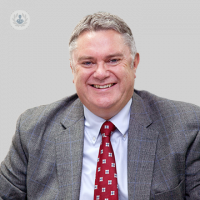Insights into blepharoplasty
Written by:Blepharoplasty, or eyelid surgery, is a procedure aimed at addressing aging-related changes in the eyelids, including sagging skin and weakened muscles. While often chosen for cosmetic reasons, it can also be a medical necessity when excess skin obstructs vision. In his latest online article, Mr Timothy Mellor gives us his insights into the surgical process, risks involved, and aftercare instructions.

What is blepharoplasty?
Blepharoplasty is a type of surgery that removes excess skin from the eyelids. With age, eyelids stretch, and the muscles supporting them weaken. As a result, excess skin and fat can gather above and below your eyelids. This can cause sagging eyebrows, droopy upper lids and bags under the eyes.
Besides aging, severely sagging skin around the eyes can reduce side vision (peripheral vision), especially the upper and outer parts of the visual field. Blepharoplasty can reduce or get rid of these vision problems. The surgery can also make eyes look younger and more alert.
Who usually gets blepharoplasty and why?
You may think eyelid surgery is performed only for cosmetic reasons. Although many procedures are done for cosmetic reasons, they can also have medical applications. For some, eyelid surgery is a medical necessity, especially if the excess skin hangs down far enough over the upper lid that it blocks vision.
What happens during a blepharoplasty procedure?
Surgery on the upper eyelids generally involves: making a cut (incision) along the eyelid crease in the natural skin fold of the eyelid, removing excess skin, fat or muscle. closing the incision – the scar will usually be hidden in the natural fold of the eyelid.
What are the risks of blepharoplasty?
All surgery has risks, including reaction to anaesthesia and blood clots. Besides those, rare risks of eyelid surgery include:
- Infection and bleeding
- Dry, irritated eyes
- Difficulty closing the eyes or other eyelid problems
- Noticeable scarring
- Injury to eye muscles
- Skin discoloration
- Temporarily blurred vision or, rarely, loss of eyesight
- The need for follow-up surgery
What is the aftercare?
Take the following steps to help you recover from surgery unless your surgeon gives you different instructions.
Do:
- Use prescribed eye drops or ointments.
- Sleep with your head raised higher than your chest for a few days.
- Wear dark sunglasses to protect the skin of your eyelids from sun and wind.
- If needed, use paracetamol to control pain.
Don't:
- Do anything strenuous for a week — no heavy lifting, swimming, jogging or aerobics.
- Smoke.
- Rub your eyes.
- Wear contact lenses for about two weeks.
- Take aspirin and other blood thinning drugs or herbal supplements that can increase bleeding.
How long does it take for the eyes to heal?
Many people who have blepharoplasty say they feel more self-confident and feel they look younger and more rested. For some people, surgery results may last a lifetime. For others, droopy eyelids can recur.
Bruising and swelling generally lessen slowly in about 10 to 14 days. Scars from the surgical cuts may take months to fade. Take care to protect your delicate eyelid skin from sun exposure.
Mr Timothy Mellor is an esteemed consultant oral and maxillofacial surgeon. You can schedule an appointment with Mr Mellor on his Top Doctors profile.


